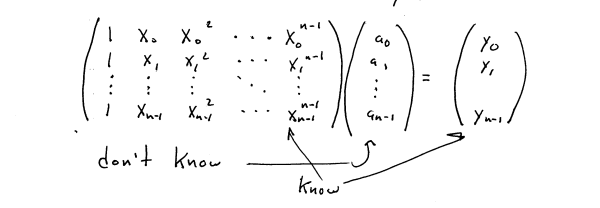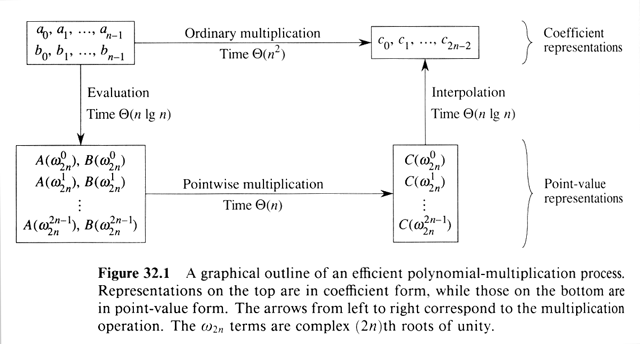Representation of Polynomials
yields the coefficient representation of A (x) with d-b n: (a0, a1,
...,an-1) a vector of the coefficients. Consider, given a0,
a1, ...,an-1 as a representation of A (x) evaluation A
(x0). We can use Horner's rule to do so in Q
(n) :
a0 + x0(a1 + x0(a2
+ x0 (a3+ ..... + x0(an-2 + x0
an-1)
This can easily be written as an iterative algorithm with a single loop
of length n ( 0 to n-1 .) Adding A (x) and B (x) is again Q
(n). (c0, c1, ...,cn-1) with cj
= aj + bj.
What about the multiplication of two d-b n polynomials A (x) and B
(x)? Polynomial multiplication via the "school book algorithm is Q
(n2), and C = (c0, c1, ...,c2n-2)
is obtained through convolution:
C = A Ä B ( Ä means
convolution). We study fast algorithm for convolution! A point-value
representation of A (x) a polynomial of d - b n point-value pairs:
{ ( x0, y0), ( x1, y1),
..., ( xn-1, yn-1) }
with all the x's distinct and y j= A (xj) . Note:
any set of n distinct x's can be used, so there are many point-value
representations of A (x)! By using Horner's rule, one can evoluate A (x) at
a point in Q (n) time, so conversion from
coefficient to point-value takes Q (n2)
time using Horner's rule n times. We will choose the x's in a special way to
obtain a Q (n lg n) algorithm. Given the
point-value representation and computing the coefficient representation of A
(x) is called interpolation.
Theorem 32.1: For any set { ( x0, y0), ( x1,
y1), ..., ( xn-1, yn-1) } of n p - v pairs
there is a unique d - b n polynomial, A (x) such that y i= A (xi)
for i = 0, ..., n - 1.
Proof: write out A (x0) = y0 , A (x1)
= y1 , ..., A (xn-1) = yn-1 as:

The matrix V (x0, x1, ...,xn-1) is
called a Vandermonde matrix and:
det (x0, x1, ...,xn-1) ¹
0 since all the x's are distinct. So the system has a solution:
a = V (x0, x1, ...,xn-1)-1
y
so the a's can be uniquely found!! Solving such a linear system takes Q
( n3 ) time, but we can interpolate faster:
LaGrange formula: given p - v, A ( x ) =
n
- 1
å
k = 0 |
Yk P
( x - xj)
j < k |
|
P ( xk - xj)
j < k |
|
|
can show that A ( x ) is a d - b n polynomial and A ( xi ) = yi
. This takes Q ( n2 )
time.
A ( x ) ® { ( x0, y0 ),
( x1, y1 ), ..., ( xn-1, yn-1 )
}
B ( x ) ® { ( x0, y0'
), ( x1, y1' ), ..., ( xn-1, yn-1'
) }
Consider C ( x ) = A ( x ) + B ( x ) so
C ( x ) ® { ( x0, y0 +
y0' ), ( x1, y1 + y1' ),
..., ( xn-1, yn-1 + yn-1' ) }
and conversion takes Q ( n )
time. What about multiplication of A ( x ) and B ( x ) both d - b n
polynomials? C ( x ) = A ( x ) B ( x ) is a d - b 2n - 1, so we must augment
the number of p - v pairs used to represent A ( x ) and B ( x ):
A ( x ) ® { ( x0, y0 ),
( x1, y1 ), ..., ( x2n-2, y2n-2 )
}
B ( x ) ® { ( x0, y0'
), ( x1, y1' ), ..., ( x2n-2, y2n-2'
) }
C ( x ) ® { ( x0, y0 y0'
), ( x1, y1 y1' ), ..., ( x2n-2,
y2n-2 y2n-2' ) }
is Q ( n ) time. If we can find a
fast way to convert coefficients to p - v pairs, use the Q
( n ) multiplication on p - v pairs, and convert back, we will
have a very fast algorithm. We do so by choosing the points for the p
- v pairs very carefully. These points are the complex roots of unity.
To multiply A ( x ) B ( x ) we:
- Use the coefficient representation, but up to degree bound 2n by
padding with zeros.
- Compute the p - v of A ( x ) and B ( x ) at the 2n roots of unity via
the FFT.
- Do point wise multiplication.
- Interpolate back from the 2n roots of unity to a coefficient
representation via inverse DFT

|







